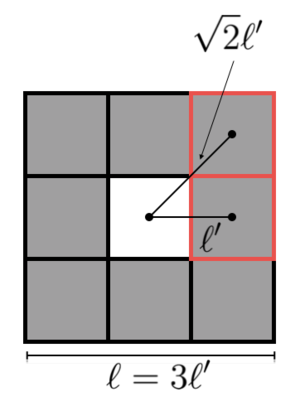Spinning up Sierpinski's carpet
Sierpenski has a square carpet of side length
l
, from which he constructs a magic carpet as follows:

- Divide the carpet into 9 equal pieces.
- Remove the piece in the middle.
- For each of the other 8 pieces, recursively apply the same steps.
The magic carpet has a non-zero moment of inertia I about an axis that pierces its center of mass and is perpendicular to the plane of the carpet. If this quantity is I = b a m l 2 , where a and b are coprime positive integers, enter a + b .
Details and Assumptions
- Note—this implies a scaling relationship between the area of the magic carpet and the mass of its component lines such that vanishing areas can have finite mass. This may seem like a paradox but recall that electrons are a type of matter with exactly this property.
The answer is 19.
This section requires Javascript.
You are seeing this because something didn't load right. We suggest you, (a) try
refreshing the page, (b) enabling javascript if it is disabled on your browser and,
finally, (c)
loading the
non-javascript version of this page
. We're sorry about the hassle.
2 solutions
The animation is misleading, I think problem setter should add in the fact that the m refers to the mass of the magic carpet after it has been finished cutting. No one buys a magic carpet with holes and measures its mass after cutting it.
The original problem/question is not phrased clearly.
The area of a Sierpinski carpet is zero, I think this means the mass and therefore the moment of inertia would be zero as well.
Log in to reply
Peter, you are right, but that does not make the problem invalid. A more formal way would be to ask b a = n → ∞ lim m n ℓ 2 I n , where I n and m n are the moment of inertia and the mass of the carpet at stage n . This fraction is well-defined.
Log in to reply
Yes Arjen, I agree that this would salvage the problem.
Log in to reply
@Peter Macgregor – I'm in agreement with @Arjen Vreugdenhil , for instance the electron is a point particle with no evidence for having any extended structure, yet it has mass. There is in principle no problem with having a structure with finite mass but vanishing area. To define the mass density, we'll need Dirac delta functions which might give some mathematicians a stroke, but that's okay.
Yes, indeed, the carpet is not constructed by starting with mass m and cutting but by distributing the mass of cut out material to the remaining pattern.
Looking at the Sierpinski carpet, we notice that each of the eight tiles on the periphery is a scaled down replica of the original Sierpinski carpet except with mass m ′ = m / 8 and length ℓ ′ = ℓ / 3 . These relationships are sketched out in the figure below.

If the moment of inertia of the Sierpinski carpet is I , we expect the moment of inertia of these small tiles about their center of mass to be given by I 8 = I m m ′ ( ℓ ℓ ′ ) 2 = 7 2 I .
According to the parallel axis theorem, if an object of mass m has moment of inertia I about an axis through its center of mass, it will have moment of inertia I ′ = m d 2 + I about an axis parallel to the original, a distance d away.
Notice that the subgroup outlined in red is repeated four times around the center of the carpet. Its moment of inertia is given by I subgroup = ( m ′ ℓ ′ 2 + I 8 ) + ( 2 m ℓ ′ l 2 + I 8 ) . Clearly, we have I = 4 I subgroup . Expressing I subgroup in terms of I , we obtain a self-consistent equation for I : I = 4 I subgroup = 4 ( m ′ ℓ ′ 2 + I 8 ) + 4 ( 2 m ′ ℓ ′ 2 + I 8 ) = 4 ( 8 m 9 ℓ 2 + 4 m 9 ℓ 2 + 2 I 8 ) = 4 ( 2 4 1 m ℓ 2 + 3 6 I )
Solving this equation, we find I = 1 6 3 m ℓ 2 .
Postscript
Note the Sierpinski carpet has zero area, so the idea of calculating its moment of inertia is something of a dubious proposition. The sleight of hand that makes it all work is to assume that the whole carpet has a non-zero moment of inertia to begin with. What this implies is that the infinitely thin lines that remain after all the subdividing has occurred are made up of Dirac point particles. In other words, a collection of points whose mass density is nonzero only in infinitesimally small regions. Moreover, it is nonzero in such a way that it contributes nonzero-mass. Take some time to think about this point.
My interpretation is rather that m = 0 , and so speaking about I = 1 6 3 m l 2 is meaningless. It could also be equal to 1 3 5 m l 2 since they are both equal to 0.
Can you look at the discussion in the other solution and see how we can fix the problem?
Log in to reply
It all depends on when you assume the finite mass. The only way for this problem to have meaning is to assume a scaling relationship between mass and the shrinking length scale. If you assume the finite mass before cutting up the carpet, then it's like you say. But there is in principle no problem with a zero area/volume object having non-zero mass. For instance, electrons satisfy this property.
Suppose the carpets moment of inertia about a perpendicular axis through its center is I = b a m ℓ 2 .
The carpet consists of eight copies of the carpet, with mass m ′ = m / 8 and length ℓ ′ = ℓ / 3 ; thus each of the eight copies has moment of inertia I ′ = b a 8 m ( 3 ℓ ) 2 = 7 2 I about a perpendicular axis through its center .
We must apply the parallel axis theorem to find the moment of inertia of each part about the perpendicular axis through the center of the entire carpet.
For the four parts left, right, above, and below the center, note that the distance between its center and the center of the entire carpet is ℓ / 3 . Thus the moment of inertia of each of these parts is I a = I ′ + m ′ d 2 = 7 2 I + 8 m ( 3 ℓ ) 2 = 7 2 I + m ℓ 2 . The four parts at the corners have a distance 3 1 2 ℓ to the center, contributing I b = I ′ + m ′ d 2 = 7 2 I + 8 m ( 3 2 ℓ ) 2 = 7 2 I + 2 m ℓ 2 . The total moment of inertia of the eight parts about the central axis of the carpet is therefore I = 4 I a + 4 I b = 1 8 1 ( 2 I + 3 m ℓ 2 ) = 9 1 I + 6 1 m ℓ 2 . Solving this we get I = 8 9 ⋅ 6 1 m ℓ 2 = 1 6 3 m ℓ 2 , making our mystery fraction equal to a / b = 3 / 1 6 , so the answer is 3 + 1 6 = 1 9 .